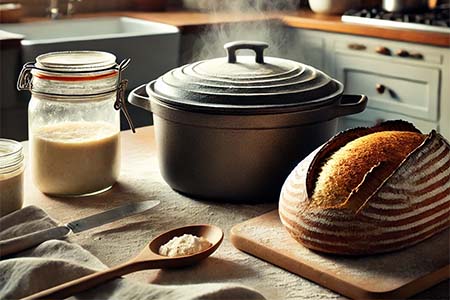Starting your sourdough journey doesn’t have to be scary. In fact, learning how to start sourdough can be one of the most rewarding—and surprisingly simple—skills you’ll ever master. The smell of fresh bread, the crackle of the crust, and the tangy, chewy center make every effort worth it. But if you’re feeling overwhelmed, you’re not alone. Many beginners think sourdough is too complicated or easy to mess up. The truth? Sourdough is more forgiving than it looks—and you can do this.
Why Start Sourdough?
Sourdough isn’t just bread—it’s tradition, science, art, and therapy all in one. The natural fermentation process makes sourdough easier to digest and gives it that signature tangy flavor. Best of all, it connects you to a slower, more intentional way of living.
If you’re a busy parent, teacher, or just someone craving a grounding hobby, sourdough baking can become your favorite daily ritual. Feeding your starter and baking bread offers a sense of calm, creativity, and accomplishment. It reminds you that nourishment comes not just from food—but from process and presence.
Common Sourdough Fears (And How to Beat Them)
1. What if I can’t keep my starter alive?
This is the most common worry when learning how to start sourdough. Think of your starter as a low-maintenance pet. It just needs regular “feeding”—a mix of flour and water. Even if it looks inactive, consistent feedings will revive it.
- Simple feeding ratio: 1:1:1 (starter:flour:water)
- Longer-lasting method: 1:5:5 (for more time between feedings)
Choose the one that fits your routine. Your starter will adapt.
2. What if my bread doesn’t rise?
Flat sourdough isn’t a failure—it’s a learning opportunity. A weak starter, under-proofing, or shaping issues can all affect the rise. Keep notes, trust the process, and remember: even a dense loaf makes amazing toast.
3. I don’t want to waste ingredients.
Start small. You can create your starter and bake test loaves with just a few grams of flour. There’s no need to go big while you’re still experimenting. Practice on a small scale, then build confidence and scale up later.
4. The process looks too complicated.
One of the easiest ways to start sourdough is by using dry sourdough starter. Here’s a simple step-by-step guide to rehydrate and activate it:
Day 1:
- Mix 1 tablespoon dry starter with 2 tablespoons room-temperature water.
- Let sit 15 minutes to soften.
- Stir in 2 tablespoons flour. Cover loosely. Leave at room temperature for 24 hours.
Day 2:
- Look for bubbles.
- Discard half the mixture.
- Feed with 2 tablespoons each of water and flour. Stir well.
Days 3–5:
- Continue discarding and feeding daily.
- By Day 5, the starter should double in size within 4–6 hours after feeding.
- Once it’s bubbly and active, it’s ready for baking!
This approach takes the guesswork out of sourdough and helps you get started with less stress.
5. What if my bread doesn’t taste right?
Flavor develops over time. Your first loaf might not taste like the artisan bread at your local bakery, but that’s part of the journey. The more you bake, the more your sourdough will develop its own signature flavor.
Want more tang? Use more starter. Prefer a mild loaf? Use less. Sourdough is flexible. Keep experimenting and trust that every loaf is progress.
Final Thoughts: Embrace the Art of Sourdough
Learning how to start sourdough isn’t just about baking—it’s about creating something meaningful from scratch. Yes, there may be a few bumps along the way. But that’s part of the magic.
You don’t need fancy tools or perfect technique. You just need flour, water, patience, and curiosity. Every baker starts somewhere, and with each loaf, you’ll learn something new. Sourdough is an art form, and like any art, it’s meant to be practiced, enjoyed, and shared.
So take a deep breath, gather your ingredients, and start your sourdough journey today. Your future self—and your kitchen—will thank you.

